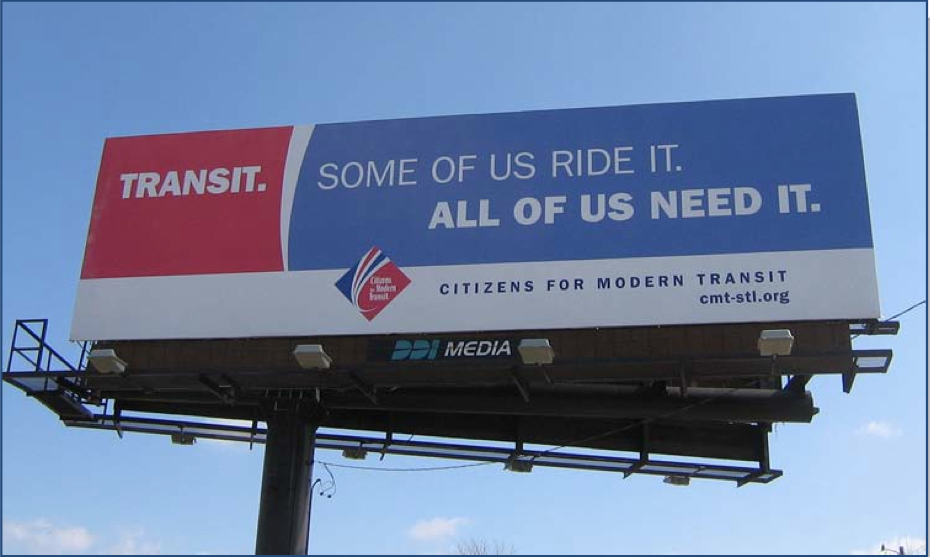PUBLIC POLICY RESEARCH CENTER, UNIVERSITY OF MISSOURI–ST. LOUIS
Introduction
On April 6, 2010 the voters of St. Louis County approved a tax increase for transit with a surprising 63 percent majority. The 1⁄2 cent sales tax now raises about $75 million a year to maintain the bus system and expand light rail. Seventeen months earlier a similar initiative had lost with 48 percent of the vote. With the economy in a recession in 2010, unemployment high, and the anti- tax Tea Party movement rising around the nation, the huge majority for Prop A was startling. In this paper we try to explain the success of Prop A and tease out the lessons for future tax initiative campaigns and civic coalitions.
Compared to the defeat of Prop M in 2008 two characteristics of the 2010 Prop A election make the victory especially surprising and help to frame our analysis: 1) Prop A succeeded in an off-year election when the composition of the electorate is less inclined to support tax increases and public transit; 2) Prop A, at least initially, did not enjoy unified business support – usually the kiss of death for transit tax initiatives.
1. Succeeding in an off-year election with a targeted turnout strategy. The “conventional wisdom” is that it is more difficult to pass transit tax initiatives in off-year elections when no state or federal offices are up for grabs. The reason is that those who are more likely to support a transit tax, such as lower income voters and minorities, turnout at lower rates in off-year elections. As Table 1 shows, the electorate in 2010 was less than a third of the size of the electorate in 2008 when the first African American won the presidency. The large African American turnout in 2008 should have helped propel Prop M to victory in St. Louis County. Indeed, Prop M received almost a quarter of a million YES votes. The problem is that it got even more NO votes. Clearly, drop-off was a problem: Prop M was the 37th item on the ballot in 2008 and, as Table 1 shows, 48,849 voters did not bother to vote on it. If a large enough majority of these nonvoters had voted YES, they would have put Prop M over the top. Facing a crowded ballot and with an electorate preoccupied by the national election, the Prop M campaign failed to motivate or inform enough sympathetic voters to search down the ballot and vote YES.
The challenge in the greatly shrunken 2010 electorate was very different. The shrunken electorate would tend to be less supportive of the transit tax. But if the campaign could motivate enough supporters to turn out (2008 showed there were plenty of transit tax supporters), then they could win (assuming opponents did not also turnout in higher numbers). The Prop A campaign concentrated on turning out its supporters rather than changing people’s minds. The challenge of a turnout strategy is to make sure that in turning out your supporters you don’t end up mobilizing your opponents as well. Mobilization producing counter-mobilization is a common theme in electoral systems where there is a great deal of slack, or low turnout, that can be motivated to vote when they see their opponents mobilizing. Moreover, the conventional wisdom is that in off-year elections tax initiatives are exposed to attack by opponents who can garner free media coverage in the absence of other high-profile electoral issues to occupy the voters. The question we address here is whether a highly targeted turnout strategy can work.
Download full report (PDF): From Checkbook Campaigns to Civil Coalitions
About The Public Policy Research Center
http://pprc.umsl.edu/
The Public Policy Research Center engages the University of Missouri – St. Louis in the metropolitan community through its work with civic, governmental, non profit, and other agencies, as well as with individuals. We invite you to explore our website to learn about the diverse services, programs, opportunities and expertise offered by the Public Policy Research Center.
Tags: campaign, Missouri, MO, Prop A, Public Policy Research Center, St. Louis, Transit, University of Missouri







 RSS Feed
RSS Feed